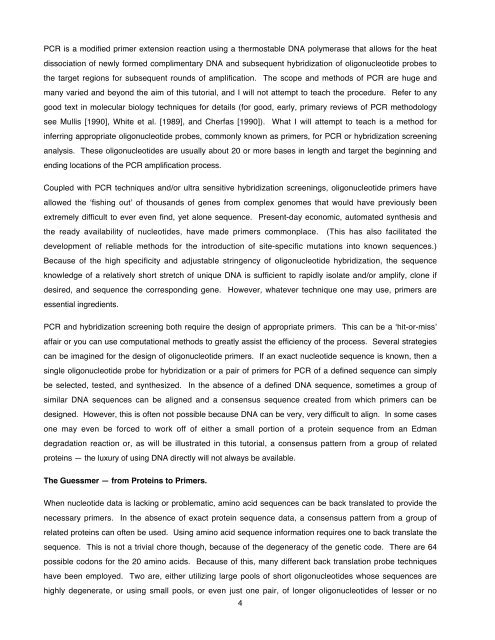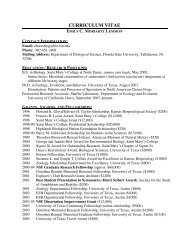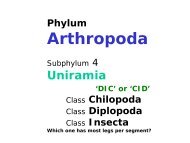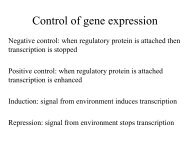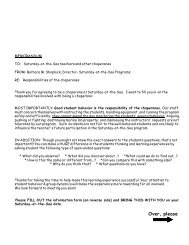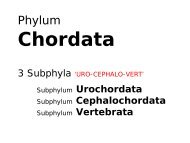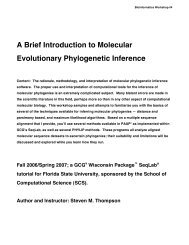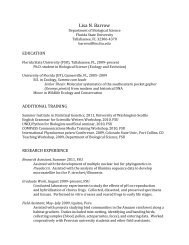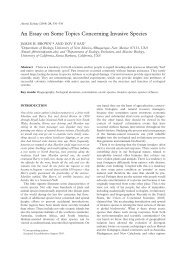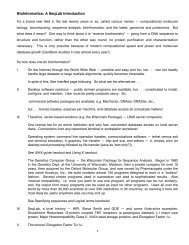Unknown DNA â Rational Primer Design and Analysis â the ...
Unknown DNA â Rational Primer Design and Analysis â the ...
Unknown DNA â Rational Primer Design and Analysis â the ...
You also want an ePaper? Increase the reach of your titles
YUMPU automatically turns print PDFs into web optimized ePapers that Google loves.
PCR is a modified primer extension reaction using a <strong>the</strong>rmostable <strong>DNA</strong> polymerase that allows for <strong>the</strong> heat<br />
dissociation of newly formed complimentary <strong>DNA</strong> <strong>and</strong> subsequent hybridization of oligonucleotide probes to<br />
<strong>the</strong> target regions for subsequent rounds of amplification. The scope <strong>and</strong> methods of PCR are huge <strong>and</strong><br />
many varied <strong>and</strong> beyond <strong>the</strong> aim of this tutorial, <strong>and</strong> I will not attempt to teach <strong>the</strong> procedure. Refer to any<br />
good text in molecular biology techniques for details (for good, early, primary reviews of PCR methodology<br />
see Mullis [1990], White et al. [1989], <strong>and</strong> Cherfas [1990]). What I will attempt to teach is a method for<br />
inferring appropriate oligonucleotide probes, commonly known as primers, for PCR or hybridization screening<br />
analysis. These oligonucleotides are usually about 20 or more bases in length <strong>and</strong> target <strong>the</strong> beginning <strong>and</strong><br />
ending locations of <strong>the</strong> PCR amplification process.<br />
Coupled with PCR techniques <strong>and</strong>/or ultra sensitive hybridization screenings, oligonucleotide primers have<br />
allowed <strong>the</strong> ‘fishing out’ of thous<strong>and</strong>s of genes from complex genomes that would have previously been<br />
extremely difficult to ever even find, yet alone sequence. Present-day economic, automated syn<strong>the</strong>sis <strong>and</strong><br />
<strong>the</strong> ready availability of nucleotides, have made primers commonplace. (This has also facilitated <strong>the</strong><br />
development of reliable methods for <strong>the</strong> introduction of site-specific mutations into known sequences.)<br />
Because of <strong>the</strong> high specificity <strong>and</strong> adjustable stringency of oligonucleotide hybridization, <strong>the</strong> sequence<br />
knowledge of a relatively short stretch of unique <strong>DNA</strong> is sufficient to rapidly isolate <strong>and</strong>/or amplify, clone if<br />
desired, <strong>and</strong> sequence <strong>the</strong> corresponding gene. However, whatever technique one may use, primers are<br />
essential ingredients.<br />
PCR <strong>and</strong> hybridization screening both require <strong>the</strong> design of appropriate primers. This can be a ‘hit-or-miss’<br />
affair or you can use computational methods to greatly assist <strong>the</strong> efficiency of <strong>the</strong> process. Several strategies<br />
can be imagined for <strong>the</strong> design of oligonucleotide primers. If an exact nucleotide sequence is known, <strong>the</strong>n a<br />
single oligonucleotide probe for hybridization or a pair of primers for PCR of a defined sequence can simply<br />
be selected, tested, <strong>and</strong> syn<strong>the</strong>sized. In <strong>the</strong> absence of a defined <strong>DNA</strong> sequence, sometimes a group of<br />
similar <strong>DNA</strong> sequences can be aligned <strong>and</strong> a consensus sequence created from which primers can be<br />
designed. However, this is often not possible because <strong>DNA</strong> can be very, very difficult to align. In some cases<br />
one may even be forced to work off of ei<strong>the</strong>r a small portion of a protein sequence from an Edman<br />
degradation reaction or, as will be illustrated in this tutorial, a consensus pattern from a group of related<br />
proteins — <strong>the</strong> luxury of using <strong>DNA</strong> directly will not always be available.<br />
The Guessmer — from Proteins to <strong>Primer</strong>s.<br />
When nucleotide data is lacking or problematic, amino acid sequences can be back translated to provide <strong>the</strong><br />
necessary primers. In <strong>the</strong> absence of exact protein sequence data, a consensus pattern from a group of<br />
related proteins can often be used. Using amino acid sequence information requires one to back translate <strong>the</strong><br />
sequence. This is not a trivial chore though, because of <strong>the</strong> degeneracy of <strong>the</strong> genetic code. There are 64<br />
possible codons for <strong>the</strong> 20 amino acids. Because of this, many different back translation probe techniques<br />
have been employed. Two are, ei<strong>the</strong>r utilizing large pools of short oligonucleotides whose sequences are<br />
highly degenerate, or using small pools, or even just one pair, of longer oligonucleotides of lesser or no<br />
4


